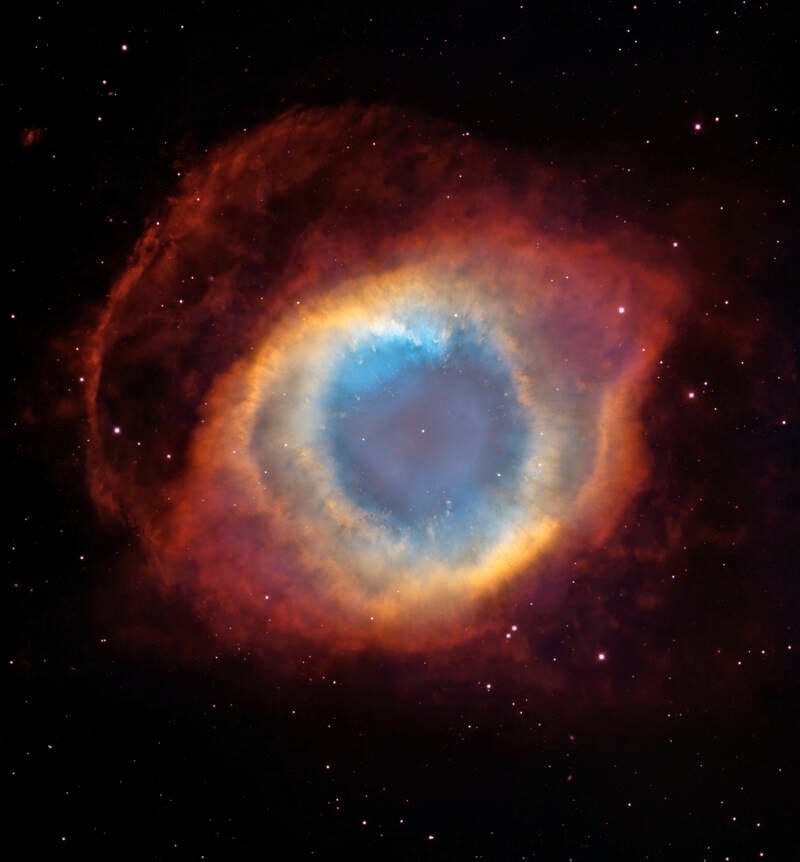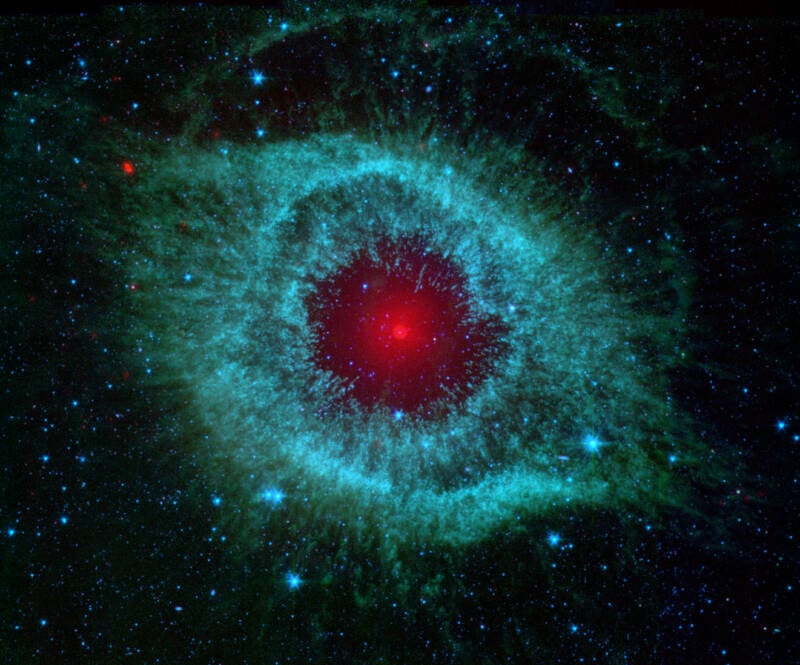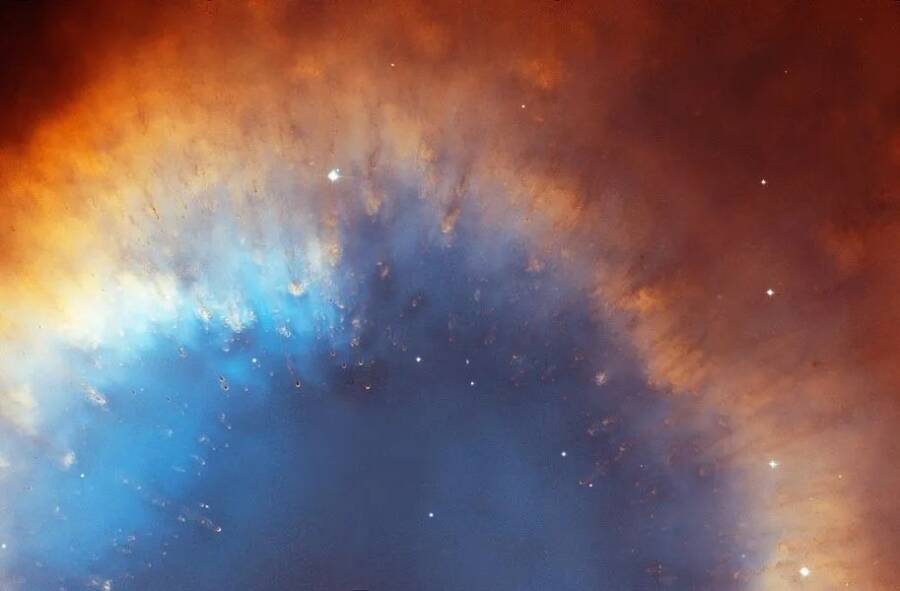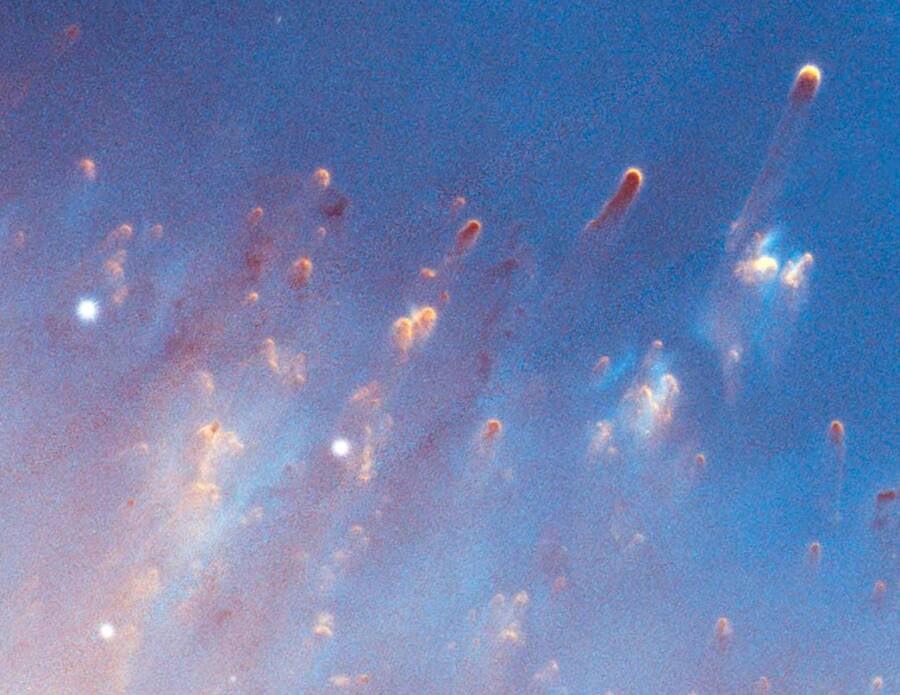For 40 years, scientists have wondered why the white dwarf at the center of the Helix Nebula was emitting such strong X-ray flares. New observations suggest those signals could be the remains of a shattered, Jupiter-sized planet.

NASA, ESA, and C.R. O’Dell (Vanderbilt University)The Helix Nebula, or Caldwell 63, a planetary nebula formed around the dying remains of a star similar to our Sun.
A new image released by NASA shows what could be a captivating — and terrifying — event roughly 650 light-years away: a dying white dwarf that may have taken a planet out with it.
The observation was made at the heart of the Helix Nebula, also known as Caldwell 63. Stretching more than three light-years across, the planetary nebula is essentially the slowly-cooling corpse of a dead star, illuminated at the center by a white dwarf that has befuddled astronomers for decades. Previous examinations from the Einstein X-ray Observatory, the Chandra X-ray telescope, and ROSAT telescopes revealed strange, high-energy X-rays coming off the white dwarf’s surface — but no one knew what was actually causing this.
However, a new study published in the Monthly Notices of the Royal Astronomical Society claims to have found the answer: the X-rays were created by fragments of a shattered planet falling onto the star’s surface.
If these observations are correct, the study could paint a terrifying vision of the long-distant future of our own solar system. After all, it’s likely that the Sun will one day become a white dwarf as well — and that means it, too, could destroy planets that come too close to its orbit.
New Observations From The Helix Nebula Suggest Its Central Star Could Be A Planet Killer
The Helix Nebula is roughly 650 light-years away from Earth and located in the constellation Aquarius. It is also one of the closest planetary nebulae to Earth, making it observable with binoculars in dark skies.
It formed when a dying star expelled its outer layers of gas, leaving behind a dense, hot core known as a white dwarf. This dying central star emits intense ultraviolet (UV) radiation, which causes the surrounding gas to glow. Its stunning visual appearance has also earned the nebula the nickname “Eye of God,” as it somewhat resembles a giant eye in the sky.

NASA/Public DomainAn infrared view of the Helix Nebula.
Naturally, the Helix Nebula caught the attention of astronomers, but previous observations only brought more questions. Strange X-rays emitting from the dying star confused researchers — white dwarfs aren’t known to emit strong X-rays. But the cause of these signals remained elusive for roughly 40 years.
What’s more, telescope observations between 1992 and 2002 showed that the X-ray signals remained constant, with subtle regular variation every 2.9 hours.
“We think this X-ray signal could be from planetary debris pulled onto the white dwarf,” said Dr. Sandino Estrada-Dorado, an astronomer from the National Autonomous University of Mexico and the study’s lead author, according to Sci News. “We might have finally found the cause of a mystery that’s lasted over 40 years.”
This shattered planet likely began its life a good distance from the white dwarf, but it may have been pulled closer and closer due to the gravity of other planets in the system. Previous observations have also shown that a Neptune-sized planet is in incredibly close revolution around the white dwarf, but as a Jupiter-like planet was pulled closer, the gravity of the white dwarf ripped it apart.

NASA/Public DomainA closer view of the clusters around the Helix Nebula.
“The mysterious signal we’ve been seeing could be caused by the debris from the shattered planet falling onto the white dwarf’s surface, and being heated to glow in X-rays,” said Dr. Martin Guerrero, an astronomer at the Institute of Astrophysics of Andalusia. “If confirmed, this would be the first case of a planet seen to be destroyed by the central star in a planetary nebula.”
This study also has significant implications for the fate of our own Sun billions of years down the line.
How A Star Like Our Sun Becomes A White Dwarf
Stars like our Sun spend the majority of their lives fusing hydrogen into helium in their cores, a process that generates the energy they emit. Over billions of years, this hydrogen fuel becomes depleted, leading to significant changes in the star’s structure and behavior.
Per Harvard’s Center for Astrophysics, as the core exhausts its hydrogen supply, it can no longer support the outward pressure needed to counterbalance gravity. This imbalance causes the core to contract and heat up, eventually causing the star to expand into a red giant with a core that is swollen and continually heating.

NASA/Public DomainA closer view of the various “knots” found within the Helix Nebula caused by colliding gases.
Once the core reaches temperatures around 100 million Kelvin, it becomes hot enough to initiate helium fusion, converting it into heavier elements like carbon and oxygen. After the helium is exhausted, the core lacks the mass required to ignite further fusion processes for heavier elements while simultaneously contracting further under gravity and expelling its outer layers, often forming a planetary nebula.
The remaining core, now devoid of fusion reactions, becomes a white dwarf — a dense, Earth-sized object with a mass comparable to the Sun’s. Over billions and billions of years, the white dwarf cools and eventually becomes a cold, dark “black dwarf.” That said, the universe is not old enough for any black dwarfs to exist yet.
In any case, the observations from the Helix Nebula are a fascinating representation of the life and death of stars in the universe. And although research estimates it will be another five billion years before our own Sun undergoes this process, it’s also a reminder that all things one day come to an end.
After reading about this fascinating astrological phenomenon, read about the seven Earth-like planets NASA discovered in a nearby star’s habitable zone. Or, see the first supernova explosion ever captured on video.





